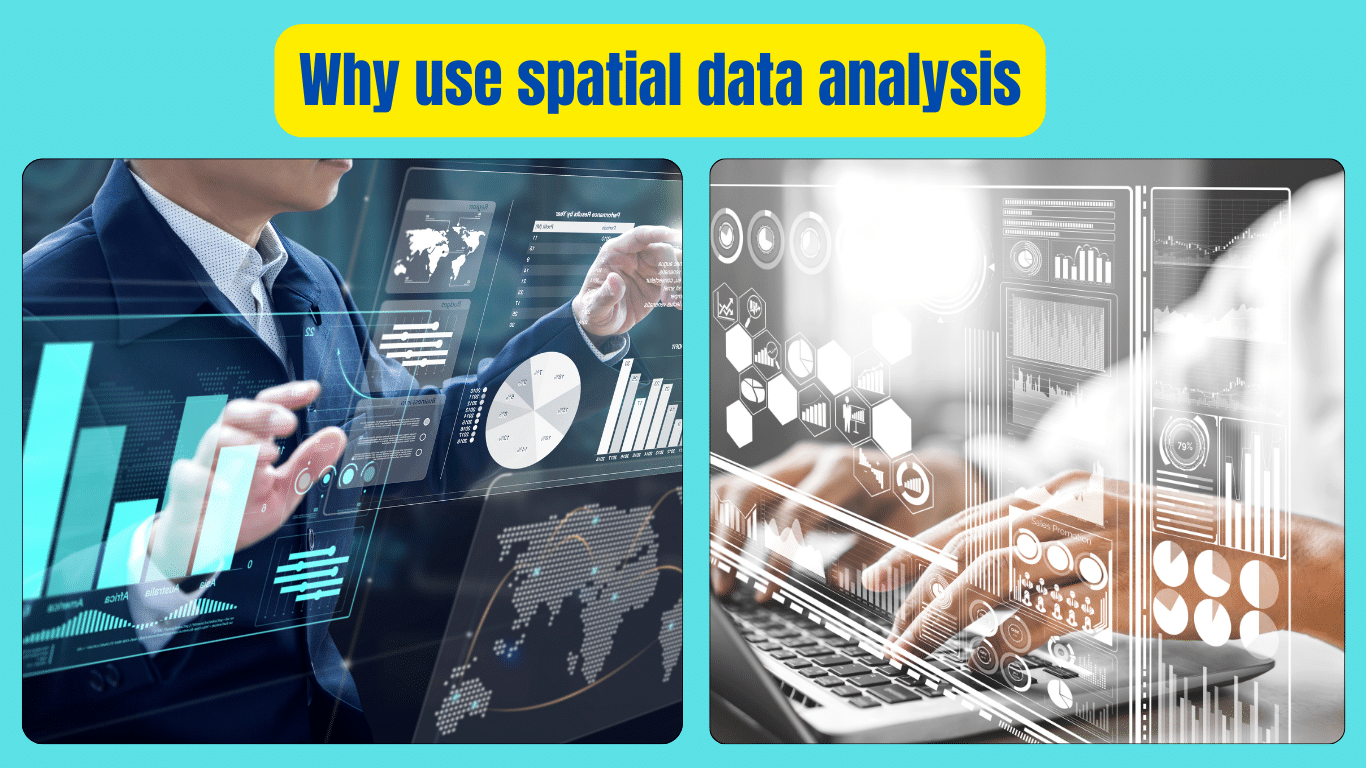Spatial data analysis is a powerful tool that helps us understand the world around us in a whole new way. By using spatial data, which is information tied to specific locations on the Earth’s surface, we can uncover patterns, trends, and relationships that might otherwise go unnoticed.
Whether it’s analyzing traffic patterns to improve city planning, mapping disease outbreaks to target healthcare resources, or studying wildlife habitats to inform conservation efforts, spatial data analysis allows us to make smarter decisions and solve complex problems. By harnessing the power of spatial data, we can gain valuable insights that help us better understand our environment and make more informed choices for the future.
Unlocking Why Use Spatial Data Analysis
In today’s digital age, data is everywhere, and its analysis holds the key to understanding complex phenomena. One type of data analysis that’s gaining increasing importance is spatial data analysis. But what exactly is spatial data analysis, and why should we use it? In this comprehensive guide, we’ll explore the world of spatial data analysis, its applications, and the benefits it offers in various fields.
Understanding Spatial Data Analysis
At its core, spatial data analysis involves examining data that is tied to specific geographical locations. This type of analysis takes into account the spatial relationships between different data points, allowing us to uncover patterns, trends, and associations that may not be apparent through other methods.
Applications of Spatial Data Analysis
Spatial data analysis finds applications across a wide range of fields, from urban planning to environmental science to public health. Let’s delve into some key areas where spatial data analysis is making a significant impact:
- Urban Planning
- Environmental Science
- Public Health
- Agriculture
Urban Planning
In urban planning, spatial data analysis plays a crucial role in designing efficient transportation systems, allocating resources, and managing infrastructure. By analyzing spatial data on population density, traffic patterns, and land use, urban planners can make informed decisions to create sustainable and livable cities.
Environmental Science
Environmental scientists use spatial data analysis to monitor changes in ecosystems, track wildlife habitats, and assess the impact of human activities on the environment. By analyzing spatial data collected from satellites, drones, and other sources, researchers can better understand complex environmental processes and develop strategies for conservation and sustainability.
Public Health
In public health, spatial data analysis helps identify disease hotspots, track the spread of infectious diseases, and allocate healthcare resources effectively. By mapping patterns of illness and analyzing demographic data, public health officials can make data-driven decisions to prevent outbreaks and improve healthcare delivery.
Agriculture
Spatial data analysis is transforming modern agriculture by enabling precision farming techniques. By analyzing spatial data on soil composition, weather patterns, and crop yields, farmers can optimize their planting strategies, minimize resource usage, and increase productivity.
Benefits of Spatial Data Analysis
The use of spatial data analysis offers several benefits across different sectors:
- Better decision-making
- Enhanced Planning and Resource Allocation
- Improved Predictive Modeling
- Increased Efficiency and Cost Savings
Better decision-making
By providing insights into spatial relationships and patterns, spatial data analysis empowers decision-makers to make more informed choices. Whether it’s optimizing transportation routes, identifying optimal locations for new infrastructure projects, or targeting resources for disaster response, spatial data analysis helps maximize efficiency and effectiveness.
Enhanced Planning and Resource Allocation
Spatial data analysis enables better planning and allocation of resources by identifying areas of need and prioritizing interventions. Whether it’s allocating healthcare resources during a pandemic, planning urban development projects, or managing natural resources, spatial data analysis helps ensure that resources are used where they are needed most.
Improved Predictive Modeling
Spatial data analysis enables the development of predictive models that can forecast future trends and outcomes. By analyzing historical spatial data and identifying patterns, researchers can develop models to predict everything from urban growth patterns to disease outbreaks to climate change impacts.
Increased Efficiency and Cost Savings
By optimizing processes and resource allocation, spatial data analysis can lead to increased efficiency and cost savings. Whether it’s optimizing supply chain logistics, reducing energy consumption, or minimizing transportation costs, spatial data analysis helps organizations operate more efficiently and sustainably.
Some Key points: Why use spatial data analysis?
Advantages of Spatial Data
Spatial data offers several advantages due to its unique characteristics. Firstly, it provides valuable information about the geographical locations of objects or phenomena, enabling better understanding and decision-making. Additionally, spatial data facilitates visualization through maps and graphs, making complex patterns and relationships easier to comprehend. Moreover, spatial data allows for the integration of various data sources, leading to comprehensive analyses and insights. Overall, the advantages of spatial data lie in its ability to enhance spatial understanding, visualization, and integration for informed decision-making.
Function of Spatial Data Analysis
The primary function of spatial data analysis is to uncover patterns, trends, and relationships within geographical data. By examining spatial data, analysts can identify clusters, distributions, and correlations that provide valuable insights into spatial phenomena. Spatial data analysis enables researchers and decision-makers to understand spatial relationships, make predictions, and formulate strategies for various applications such as urban planning, environmental management, and public health.
Purpose of Using Spatial Database
Spatial databases are used to store, manage, and analyze spatial data efficiently. They provide a structured framework for organizing spatial information, allowing users to query, retrieve, and manipulate data based on geographical criteria. Spatial databases are essential for applications that require spatial analysis, such as geographic information systems (GIS), urban planning, and environmental monitoring. By utilizing spatial databases, organizations can leverage spatial data effectively to support decision-making and enhance operations.
Need for Spatial Data
The need for spatial data arises from the inherent spatial dimension of many real-world phenomena. Spatial data provides critical information about the location, distribution, and relationship of objects or events, which is essential for understanding spatial patterns and processes. Whether it’s analyzing traffic patterns in a city, mapping disease outbreaks, or assessing natural resource distribution, spatial data helps address various societal and environmental challenges by providing insights into spatial relationships and trends.
Mostly Used for Spatial Analysis
Geographic Information Systems (GIS) are primarily used for spatial analysis. GIS software enables users to visualize, query, analyze, and interpret spatial data effectively. With GIS, analysts can perform a wide range of spatial analyses, including spatial querying, overlay analysis, proximity analysis, and spatial interpolation. GIS is widely used across various industries and disciplines, including urban planning, environmental science, public health, and natural resource management.
Concepts of Spatial Analysis
Spatial analysis encompasses five key concepts: spatial relationships, spatial autocorrelation, spatial distribution, spatial interpolation, and spatial clustering. Spatial relationships refer to the connections and interactions between spatial entities. Spatial autocorrelation examines the degree of similarity between neighboring spatial units. Spatial distribution describes the arrangement or pattern of spatial phenomena across a geographic area. Spatial interpolation estimates values at unsampled locations based on nearby sampled data points. Spatial clustering identifies groups or clusters of spatial entities based on their proximity or similarity.
Applications of Spatial Data
Spatial data is used in various fields and applications, including urban planning, environmental management, public health, agriculture, transportation, and natural resource management. Urban planners use spatial data to design efficient transportation systems and allocate resources effectively. Environmental scientists utilize spatial data to monitor ecosystems, track wildlife habitats, and assess environmental impacts. Public health officials use spatial data to identify disease hotspots, track the spread of infectious diseases, and plan healthcare interventions.
Performing Spatial Analysis
To perform spatial analysis, one needs access to spatial data and appropriate analytical tools, such as GIS software. The process typically involves data acquisition, data preprocessing, analysis, and interpretation. Analysts use spatial analysis techniques such as overlay analysis, proximity analysis, and spatial interpolation to examine spatial relationships, patterns, and trends. By applying spatial analysis, researchers and decision-makers can gain insights into complex spatial phenomena and make informed decisions to address various challenges and opportunities.
Conclusion
In conclusion, spatial data analysis is a powerful tool that offers insights into complex spatial relationships and patterns. From urban planning to environmental science to public health, the applications of spatial data analysis are vast and diverse. By harnessing the power of spatial data analysis, organizations and decision-makers can make more informed choices, allocate resources more effectively, and address some of the most pressing challenges facing our world today. Whether it’s improving city planning, protecting the environment, or enhancing public health, spatial data analysis is helping to shape a better future for us all.
FAQs
What is spatial data analysis?
Spatial data analysis is a method of examining data that’s linked to specific locations on Earth’s surface to uncover patterns and relationships.
Why is spatial data analysis important?
It helps us understand how things are arranged in space, which is crucial for making decisions about things like city planning, health, and the environment.
What kinds of information can be analyzed using spatial data analysis?
Any information that has a location tied to it, like population density, disease outbreaks, or even wildlife habitats,.
How does spatial data analysis benefit urban planning?
It assists in designing better transportation systems, deciding where to build new infrastructure, and managing resources in cities.
How does spatial data analysis help in environmental science?
It allows scientists to monitor changes in ecosystems, track wildlife movements, and understand the impact of human activities on the environment.
What role does spatial data analysis play in public health?
It helps identify areas with high disease rates, track the spread of illnesses, and allocate healthcare resources where they’re needed most.
Can spatial data analysis be used in agriculture?
Yes, it helps farmers optimize crop planting, manage soil quality, and conserve resources like water and fertilizer.
How does spatial data analysis contribute to disaster response?
It aids in predicting and mitigating the impact of natural disasters by identifying vulnerable areas and planning evacuation routes.
Who uses spatial data analysis?
Urban planners, environmental scientists, public health officials, farmers, and many other professionals use it to make informed decisions.
What software or tools are used for spatial data analysis?
Geographic Information Systems (GIS) software like ArcGIS, QGIS, and Google Earth are commonly used for spatial data analysis.






